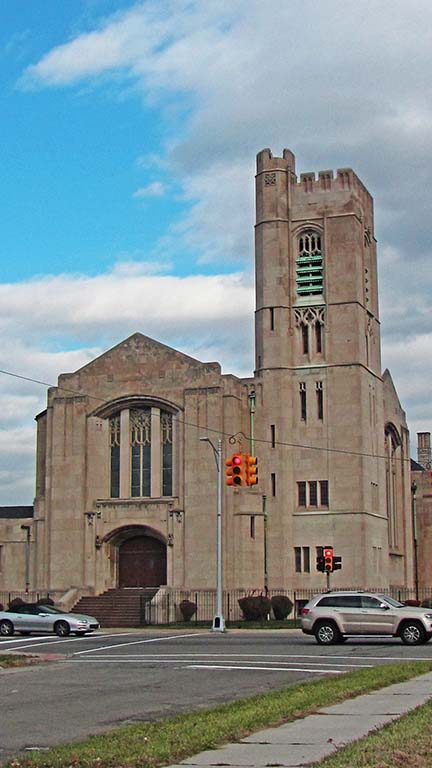

The congregation was established by Cass United Methodist to serve Methodists who lived in Highland Park. Presumably, there were Methodists who would have attended Cass United but they lived too far away.
Highland Park, located on a ridge six miles northwest of the Detroit’s riverfront, is surrounded by the city of Detroit except for a short stretch of its border which it shares with Hamtramck. It is now basically a small impoverished, almost all African American enclave within Detroit. It was once a large, prosperous city with several upscale neighborhoods. Judge Augustus Woodward thought the higher land would make an ideal site for a settlement so he bought the area in 1818 and platted the village of Woodward whose main street, I presume, would have been Woodward Avenue. He failed to attract settlers. In 1836, Judge Benjamin F. Witherell, the son of James Witherell who was appointed by President Thomas Jefferson to serve as the third federal judge in Michigan territory, also tried to develop a settlement here but was no more successful than Woodward.
As Detroit became an industrial metropolis after the Civil War, a few settlers came to the area that is now Highland Park. They were in sufficient numbers such that Highland Park became a chartered village in 1889. In 1907, Henry Ford purchased 160 acres and, in 1909, began building the huge vehicle plant that still stands along Woodward. In 1914, he developed the assembly line at his Highland Park factory and, within a few years, he was able to turn out 9,000 Model T’s each workday. Detroit annexed many contiguous areas in the first two decades of the last century. Ford wanted to preserve independence from the powerful city of Detroit so Highland Park was chartered as a city in 1918. Real estate developer William Stevens also played a role in the independence movement that established the city of Highland Park.
This location has one of the most unusual demographic trajectories of any place in the country. In 1910, there were only 4,000 residents but blue and white collar employees moved close to the Ford plant in that decade and several other Highland Park vehicle plants that would eventually become part of the Chrysler Corporation. Indeed, until 1990 Highland Park was the headquarters site for Chrysler. In 1920, Highland Park’s population soared to 47,000. Presumably, it was in this First World War I decade that Cass United Methodist established the congregation that built the church pictured above. Growth continued in the booming 1920s and Highland Park reached its peak population in 1930: 53,000. It has consistently lost population since then, although much more rapidly following World War II. The Census Bureau estimated Highland Park had 11,000 residents in 2012. I suspect that among cities that once exceeded fifty thousand, Highland Park has lost the highest percentage of its residents. Very much linked to the population decline and the exodus of employment is the fact that Highland Park’s insolvent government was taken over by the state in 2001. They gained their freedom from state control about eight years later but continuing financial problems put the city on the cusp of state control once again in 2013. When the Highland Park school system ran out of money, the state took over the schools in 2012 and continues to operate them.
Highland Park is no longer the city that could fund the elegant McGregor Library or attract upscale residents for its two historic districts: the Highland Heights-Stevens and the Medbury-Grove Lawn subdivisons. In late 2013, the Census Bureau released information from their recent surveys of Highland Park. Forty seven percent of the residents and 61 percent of the children lived in poverty.
The congregation selected one of the most experienced and accomplished Detroit architects: George DeWitt Mason. He designed a neo-Gothic church in gray limestone. Along Woodward, you see a gabled two-story entrance pavilion with a traceried arched window. Alongside the entrance is a tall, flat roofed crenelated tower with a louvered belfry. This is quite an austere church with much less ornamentation than you might expect. The campus includes an attached chapel, also a rock faced granite Gothic structure with an octagonal aspe. This was, I believe, among the last Gothic churches built in Detroit. By the time the suburban church building boom took off after World War II, Gothic had gone out of style. Trinity United is an impressive and beautiful church. The tower on Woodward is especially striking.
The Methodist congregation ceased using this church in 1978, reflecting the migration of many from Highland Park to the suburban ring. Actually, it is a little surprising that this congregation remained until almost 1980. In 2013, the church was home to the New Mount Moriah congregation.
Architect: George D. Mason
Architectural Style: Gothic Revival
Date of construction: 1922
Use in 2013: New Mount Moriah Baptist
State of Michigan Registry of Historic Sites: Listed P25,327
National Register of Historic Places: Listed, August 3, 1982, in the Woodward Avenue Religious Structures Thematic Resource
Photograph: Ren Farley; November 9, 2013
Description Updated: April, 2014
Return to Religious Structures
Return to Woodward Avenue Religious Structures Thematic Resource